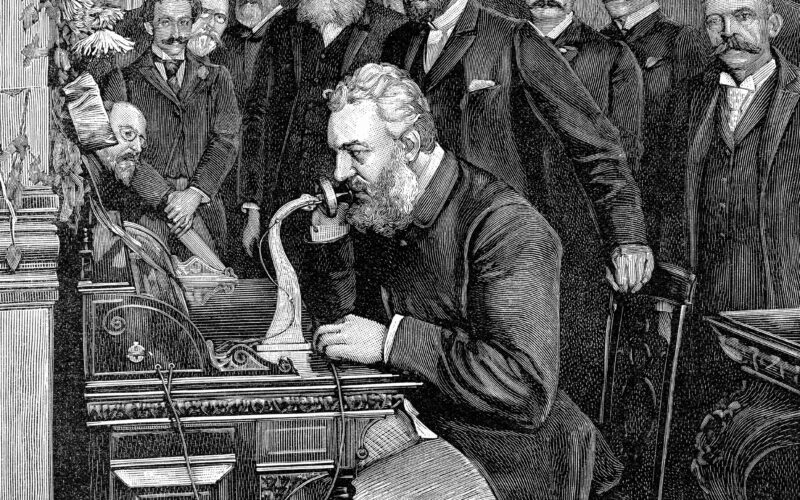None of us can imagine a world without smartphones. But what we take for granted with today’s advanced Android and iPhone functionality grew by fits and starts—with gaps of several years between breakthroughs—over 45 years of cell phone development. That four and a half decades comprised the global evolution from 1G (the first-generation cellular network) to 5G (the fifth generation), during which:
- cell phones have become smaller
- download speeds are much faster
- text messaging has come (and almost gone)
- surfing the internet with phones is common
- social media posting has exploded, and
- there’s an app for pretty much everything
During roughly every decade since 1979, each new wireless network generation has changed how we communicate, in ways that improved—and sometimes complicated—our way of life. Following are common questions people ask about mobile phones’ march from 1G to 5G.
Who invented mobile and why?
The first truly mobile phone service emerged on June 17, 1946, at Bell Labs1, which developed mobile phones allowing users to place and receive phone calls from their cars. Soon after that, AT&T offered the first Mobile Telephone Service (MTS)1, with limited coverage in urban regions.
Early European breakthroughs
Sweden rolled out the first fully automated vehicular mobile phone system in 1956. Named MTA (Mobiltelefonisystem A)1, with this system, users could make and receive calls with a rotary dial. These primitive car phones had bulky vacuum tubes and relays and weighed as much as 90 pounds.
Other car phone systems were implemented around this time as well. The USSR introduced the first mobile phone for motorists in 1958 and the first U.S. car phones were introduced in 19591.
Russian engineer Leonid Kupriyanovich developed several experimental mobile phone models between 1957 and 19611. The last weighed less than three ounces and could fit easily in your palm, according to USSR media sources.
In 1965, Bulgarian-based Radioelektronika introduced a mobile automatic phone1. The device, Inforga-65, was presented at the Inforga-65 international exhibition in Moscow. The phone was based on the system Kupriyanovich developed. It worked with a base station; one base station could service up to 15 customers.
Another expanding technology was the satellite phone, first developed in 1979 for use on the high seas1. That technology is still useful in areas that landline, cellular, and marine VHF radio stations can’t reach.
AT&T’s early breakthroughs
AT&T introduced the first major mobile telephony improvements in 19651, giving its nearly twenty-year-old MTS system a new name: Improved Mobile Telephone Service (IMTS). The new system added radio channels for more simultaneous calls in a geographical region. The system included customer dialing, eliminating the need for calls to manual operators. AT&T also reduced the equipment’s size and weight and signed an agreement with New York state regulators to limit service to 40,000 customers. In New York City, 2,000 customers had to share 12 radio channels and had to wait about 30 minutes to place a call.
The mobile landscape radically changed in the early 1970s, when Bell Labs researchers began to envision a national, publicly available cellular phone network2,3. They planned to cover the country with six-sided cells. Each cell would contain a base station that sent and received messages from mobile phones over radio frequencies. To eliminate interference, neighboring cells would operate at different frequencies. The cell stations would connect radio signals with the main telecommunications network, and phones would seamlessly switch frequencies as they moved between cells.
At the end of the 1970s, the Bell Labs Advance Mobile Phone System (AMPS) was up and running on a small scale2,3. This-first generation mobile wireless network was analog and had severe limitations. Low sound quality made listening to somebody over an analog network tough. You had to deal with static noise, background crackling, and no roaming support. Security didn’t exist, because analog networks weren’t encrypted; anybody with a radio scanner could eavesdrop on your call. The download speed was also incredibly slow, because it only reached around 2.4kbps.
What was the first 1G network?
Ameritech launched the first 1G (first generation) network in the US on March 6, 19831. It cost $100 million to develop and took 10 years to reach the market. Phone talk time was limited to 30 minutes and phones took a whopping 10 hours to charge. Nevertheless, the system had a waiting list in the thousands.
What was the first cell phone?
In 1984, Martin Cooper, a Motorola engineer, developed something like the Star Trek communicator that TV audiences everywhere had seen used by Captain Kirk and Mr. Spock on the Star Trek series.2,3 “We knew that people didn’t want to talk to cars, or to houses, or to offices; they want to talk to other people … [so] the telephone number should be a person rather than a location,” Cooper recalled. His brainchild was DynaTAC, the first hand-held phone that could connect over Bell Lab’s AMPS cellular network. DynaTAC weighed in at nearly two pounds. With tongue in cheek, people called it The Brick. It soon became a must-have for financiers and entrepreneurs—but the public at large was still out of luck.
When did cell phones become available to the public?
In 1979, during a period of rapid economic expansion, Japan’s Nippon Telegraph and Telephone first introduced the citizens of Tokyo to 1G (the first-generation cellular network)4. By 1984, 1G covered all of Japan, making it the first country to have 1G service nationwide. Canada got 1G coverage in the mid-1980s.
When was the 2G network introduced?
Following 1G’s success, 2G launched on the Global System for Mobile Communications (GSM) in Finland in 19913. 2G delivered many advancements. It introduced encrypted calls—meaning nobody could eavesdrop on your calls anymore. It significantly boosted sound quality, reducing static and crackling noises. And downloads sped up considerably, averaging about 0.2 Mbps during its lifetime (still incredibly slow by today’s 5G standards).
The 2G network also let your transfer data bits from one phone to another, enabling access to media content on cellphones—including things such as ring tones. With the introduction of transfer data, 2G also delivered basic smartphone functionality. “Candy bar phones” became popular, with Nokia in the lead producing popular cellphones such as the Nokia 3210.
What year did texting start?
In 1992, 2G’s data transfer capability completely changed how we communicate, by introducing two new forms of communication: text messages (SMS) and multimedia messages (MMS). Using the same control channels as talk, SMS and MMS messages are sent in packets of data from your cell phone to a tower then to your friend’s phone.
As texting, downloading, and talking over the phone became commonplace, the 2G network generated massive consumer and business cell phone adoption—which increased the demand for data and speed.
When did the iPhone come out?
Apple brought out the first iPhone in 20075, and within a few years, it would dominate the smartphone (and cell phone) marketplace. But during the previous six years, fierce competition raged between Apple and Nokia in the smartphone arena.
When was 3G introduced?
Deployed for the public in Japan by NTT DoCoMo in 20014, 3G broke fresh ground by standardizing vendors’ network protocol. As a result, users could access data from anywhere. That introduced international roaming services. Compared to 2G, 3G had four times the data transferring capabilities, reaching up to 2 Mbps on average. Video streaming, video conferences, and live video chats emerged. Emails also became standard on mobile devices.
What was the first mobile phone with internet?
Two mobile phone companies ushered in Internet surfing during the 3G era: Blackberry and Apple, major competitors at the time. What made 3G so revolutionary was the ability to surf the internet (basic HTML pages at the time) and stream music at much faster download speeds than with 2G. Although candy-bar and flip phones were still popular, smartphones were the flashy new kids on the block. They let you to listen to music, call, text, and search the Internet. Improvements to the 3G network also increased speeds and support.
Blackberry launched its first Internet-enabled mobile device in 2002: the Blackberry 5810. It wasn’t until 2007 that the original iPhone came out5. Then, in 2008, Apple released the iPhone 3G or (iPhone 2), which paved the way for today’s smartphones. Apple’s demand was so high that 1 million iPhone 3Gs sold over the opening weekend. By 2017, Blackberry’s market share fell to 0%6. And as smartphone demand burgeoned, so did the demand for faster data and increased network capabilities.
When was 4G introduced?
4G, which brought in today’s standard smartphone services, emerged commercially in Norway at the end of 20093. Starting at a minimum of 12.5 Mbps, 4G delivered high-quality video streaming/chat, fast mobile web access, HD videos, and online gaming. 4G could do everything 3G could, but faster3. 4G also offered high-definition mobile TV, videoconferencing, and other data-intensive applications, including YouTube videos and Spotify. Compared to a simple SIM card switch from 2G to 3G, mobile devices had to be designed to support 4G.
What you may not know, however, is that when 4G first came out, it wasn’t actually 4G. When the ITU Radiocommunication Sector (ITU-R) set the required minimum speeds for 4G (12.5 Mbps), 4G couldn’t deliver. Since tech manufacturers had invested a lot of money into achieving such speeds, the ITU-R decided LTE (Long-term evolution) could be labelled 4G—but only if it significantly improved over 3G. That meant you were actually getting 3.9G or 3.95G.
By mid-2011, Canada launched its first LTE wireless network in Ottawa, Ontario, courtesy of Rogers Communications Inc. This launch offered speeds just under 12.5 Mbps and was called 4G LTE. These days, speeds are much faster. In 2020, Canada’s median 4G download speed was 55.5 Mbps.
During the 4G era, the best-selling cellphones included iPhone 6 (22.4 million units) and the Samsung Galaxy S4 (80 million units worldwide).
When was 5G first invented?
Rather than having a single inventor, 5G technology emerged through the collaboration of numerous researchers, engineers, and companies globally7. The 5G standard was developed by the 3rd Generation Partnership Project (3GPP), a global organization that brings together experts from the telecommunications industry, academia, and government institutions.
Companies that played a significant role in 5G’s development include AT&T, Ericsson, Huawei, Nokia, Qualcomm, and Samsung. They have invested heavily in research and development to create the 5G standards and technologies now deployed globally.
When did 5G become active?
On December 21, 2018, AT&T became the first and only company in the U.S. to offer a mobile 5G device over a commercial, standards-based mobile 5G network8. In March 2019, South Korea offered 5G commercially to its citizens3; it was rolled out by KT, LG Uplus, and SK Telecom—all South Korean telecom providers. 5G in Canada was first introduced in major cities in 20209; and Canadian 5G coverage radically expanded in 202210.
A big difference between 4G and 5G is its latency and bandwidth size. Latency is the time it takes for an IP packet to reach the destination, measured in milliseconds (ms). The lower the latency, the faster data gets to the digital service end point. 5G significantly reduced latency by delivering faster download and upload speeds. Comparing the two, 4G has an average latency of around 50 milliseconds, whereas 5G’s average latency is expected to be about 10. 5G could even drop down to 1 millisecond of latency.
5G also has a larger frequency range (between 30GHz and 300 GHz), supporting more technologies and devices. 5G is an essential requirement of mass Internet of Things (IoT) deployments, needed for smart cities and other industries.
Where will 5G take us in the future?
5G’s new network capabilities will launch the next digital revolution and take us far beyond smartphones and Internet connectivity11. 5G is so fast, it will enhance machine-to-machine connectivity in a new automated society, using technologies such as AI11.
In fact, 5G may just change our lives in a way 1G changed them over 40 years ago.
This article is AT&T sponsored content written by Robert Rivenbark, an AT&T contractor and a TechBuzz contributor. The statements in this article are his own and don’t necessarily represent the positions, strategies, or opinions of AT&T.
1 https://www.redorbit.com/reference/the-history-of-mobile-phone-technology/
4 https://edition.cnn.com/2001/BUSINESS/asia/05/30/hk.japan.3g/
5 https://www.apple.com/newsroom/2007/01/09Apple-Reinvents-the-Phone-with-iPhone/
6 https://www.extremetech.com/mobile/244499-blackberrys-global-market-share-just-fell-0
7 https://medium.com/@andrijunio/5-g-who-invented-it-8bb71f8e0ab1
9 https://www.engadget.com/2020-03-06-rogers-first-5g-network-in-canada-live.html
10 https://www.pcmag.com/news/fast-5g-expands-radically-in-canada





